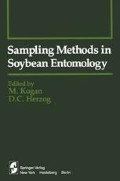Abstract
The need for rapid yet reliable sampling methods for insect pests becomes more apparent as emphasis on implementation of pest management programs increases. Design of a sampling program in which allocation of sampling resources and cost are considered is one of the first and most important steps in developing effective control strategies. The soybean producer must decide, or have someone decide for him, whether soybean pests are present in sufficient numbers to justify the expense of specific management tactics (e.g., insecticide application). Also, assessment of the densities of the naturally occurring biological control agents is becoming more important in the decision-making processes.
Technical contribution no. 1523, published by permission of the Director, South Carolina Agricultural Experiment Station.
Access this chapter
Tax calculation will be finalised at checkout
Purchases are for personal use only
Preview
Unable to display preview. Download preview PDF.
References
Allen, J., D. Gonzalez, and D. V. Gokhale. 1972. Sequential sampling plans for the bollworm, Heliothis zea. Environ. Entomol. 1: 771–780.
Anscombe, F. J. 1949. Large-sample theory of sequential estimation. Biometrika 36: 455–458.
Bliss, C. I., and A. R. G. Owen. 1958. Negative binomial distributions with a common k. Biometrika 45: 37–58.
Casey, J. E., R. D. Lacewell, and W. Sterling. 1975. An example of economically feasible opportunities for reducing pesticide use in commercial agriculture. J. Environ. Qual. 4: 60–61.
Gates, C. E., and F. G. Ethridge. 1972. A generalized set of discrete frequency distributions with Fortran program. J. Int. Assoc. Math. Geol. 4: 1–7.
Gonzalez, D. 1971. Sampling as a basis for pest management strategies. Proc. Tall Timbers Conf. Ecol. Anim. Contr. Habitat Manage. 2: 83–101.
Hammond, R. B., and L. P. Pedigo. 1976. Sequential sampling plans for green cloverworm in Iowa soybeans. J. Econ. Entomol. 69: 181–185.
Harcourt, D. G. 1966. Sequential sampling for the imported cabbageworm, Pieris rapae (L.). Can. Entomol. 98: 741–746.
Ingram, W. R., and S. M. Green. 1972. Sequential sampling for bollworms on raingrown cotton in Botswana. Cotton Grow. Rev. 49: 265–275.
Kogan, M., W. G. Ruesink, and K. McDowell. 1974. Spatial and temporal distribution patterns of the bean leaf beetle, Cerotoma trifurcata (Forster), on soybeans in Illinois. Environ. Entomol. 3: 607–617.
Kogan, M., S. G. Turnipseed, M. Shepard, E. B. de Oliveira, and A. Borgo. 1977. Pilot insect pest management program for soybean in southern Brazil. J. Econ. Entomol. 70: 661–663.
Kuno, E. 1969. A new method of sequential sampling to obtain the population estimates with a fixed level of precision. Res. Popul. Ecol. 11: 127–136.
Lloyd, M. 1967. ‘Mean crowding.’ J. Anim. Ecol. 36: 1–30.
Morris, R. F. 1954. A sequential sampling technique for spruce budworm egg surveys. Can. J. Zool. 32: 303–313.
Onsager, J. A. 1976. The rationale of sequential sampling, with emphasis on its use in pest management. USDA Tech. Bull. 1526: 19 p.
Pieters, E. P. 1978. Bibliography of sequential sampling plans for insects. Bull. Entomol. Soc. Amer. 24: 372–374.
Pieters, E. P., and W. L. Sterling. 1974. A sequential sampling plan for the cotton fleahopper, Pseudatomoscelis seriatus. Environ. Entomol. 3: 102–106.
Pieters, E. P., and W. L. Sterling. 1975. Sequential sampling cotton squares damaged by boll weevils or Heliothis spp. in the coastal bend of Texas. J. Econ. Entomol. 68: 543–545.
Sevacherian, V., and V. M. Stern. 1972. Sequential sampling plans for Lygus bugs in California cotton fields. Environ. Entomol. 1: 704–710.
Shepard, M. 1973. A sequential sampling plan for treatment decisions on the cabbage looper on cabbage. Environ. Entomol. 2: 901–903.
Shepard, M., and G. R. Camer. 1976. Distribution of insects in soybean fields. Can. Entomol. 108: 761–771.
Southwood, T. R. E. 1978. Ecological methods with particular reference to the study of insect populations. Halsted Press, N.Y. 524 p.
Stark, R. W. 1952. Sequential sampling of the lodgepole needle miner. For. Chron. 28: 57–60.
Sterling, W. L. 1975. Sequential sampling of cotton insect populations. Belt-wide Cotton Prod. Res. Conf. Proc. pp. 133–136.
Sterling, W. L. 1976. Sequential decision plans for the management of cotton arthropods in south-east Queensland. Aust. J. Ecol. 1: 265–274.
Sterling, W. L., and E. P. Pieters. 1974. A sequential sampling package for key cotton arthropods in Texas. Tex. Agr. Exp. Sta. Tech. Rep. 74-32:28 p.
Sterling, W. L., and E. P. Pieters. 1975. Sequential sampling for key arthropods of cotton. Tex. Agr. Exp. Sta. Tech. Rep. 75-24:121 p.
Sterling, W. L., and E. P. Pieters. 1979. Sequential decision sampling. S. Coop. Ser. Bull. 231: 85–101.
Strayer, J., M. Shepard, and S. G. Turnipseed. 1977. Sequential sampling for management decisions on the velvetbean caterpillar, Anticarsia gemmatalis (Hubner), on soybeans. J. Ga. Entomol. Soc. 12: 220–227.
Talerico, R. L., and R. C. Chapman. 1970. SEQUAN. A computer program for sequential analysis. U.S. For. Serv. Res. Note NE 116: 6 p.
Tumipseed, S. G. 1972. Response of soybeans to foliage losses in South Carolina. J. Econ. Entomol. 65: 224–229.
Waddill, V. H., B. M. Shepard, S. G. Turnipseed, and G. R. Camer. 1974. Sequential sampling plans for Nabis spp. and Georcoris spp. on soybeans. Environ. Entomol. 3: 415–419.
Wald, A. 1943. Sequential analysis of statistical data: theory. Columbia Univ. Stat. Res. Grp. Rep. 75 and Off. Sci. Res. Develop. Rep. 1998.
Wald, A. 1945. Sequential tests of statistical hypothesis. Ann. Math. Stat. 16: 117–186.
Waters, W. E. 1955. Sequential sampling in forest insect surveys. For. Sci. 1: 68–79.
Waters, W. E. 1959. A quantitative measure of aggregation in insects. J. Econ. Entomol. 52: 1180–1184.
Editor information
Editors and Affiliations
Rights and permissions
Copyright information
© 1980 Springer-Verlag New York Inc.
About this chapter
Cite this chapter
Shepard, M. (1980). Sequential Sampling Plans for Soybean Arthropods. In: Kogan, M., Herzog, D.C. (eds) Sampling Methods in Soybean Entomology. Springer Series in Experimental Entomology. Springer, New York, NY. https://doi.org/10.1007/978-1-4612-9998-1_4
Download citation
DOI: https://doi.org/10.1007/978-1-4612-9998-1_4
Publisher Name: Springer, New York, NY
Print ISBN: 978-1-4613-8069-6
Online ISBN: 978-1-4612-9998-1
eBook Packages: Springer Book Archive

